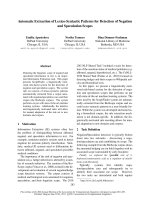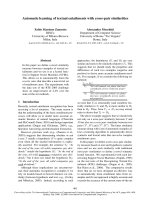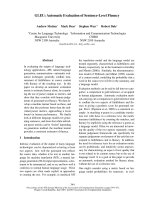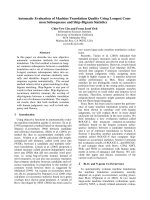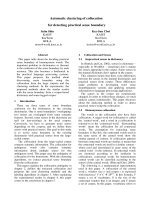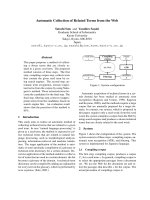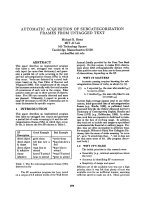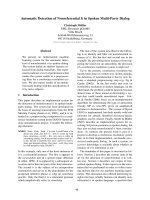Báo cáo khoa học: "Automatic Acquisition of Adjectival Subcategorization from Corpora" docx
Bạn đang xem bản rút gọn của tài liệu. Xem và tải ngay bản đầy đủ của tài liệu tại đây (151.54 KB, 8 trang )
Proceedings of the 43rd Annual Meeting of the ACL, pages 614–621,
Ann Arbor, June 2005.
c
2005 Association for Computational Linguistics
Automatic Acquisition of Adjectival Subcategorization from Corpora
Jeremy Yallop
∗
, Anna Korhonen, and Ted Briscoe
Computer Laboratory
University of Cambridge
15 JJ Thomson Avenue
Cambridge CB3 OFD, UK
, {Anna.Korhonen, Ted.Briscoe}@cl.cam.ac.uk
Abstract
This paper describes a novel system
for acquiring adjectival subcategorization
frames (SCFs) and associated frequency
information from English corpus data.
The system incorporates a decision-tree
classifier for 30 SCF types which tests
for the presence of grammatical relations
(GRs) in the output of a robust statisti-
cal parser. It uses a powerful pattern-
matching language to classify GRs into
frames hierarchically in a way that mirrors
inheritance-based lexica. The experiments
show that the system is able to detect SCF
types with 70% precision and 66% recall
rate. A new tool for linguistic annotation
of SCFs in corpus data is also introduced
which can considerably alleviate the pro-
cess of obtaining training and test data for
subcategorization acquisition.
1 Introduction
Research into automatic acquisition of lexical in-
formation from large repositories of unannotated
text (such as the web, corpora of published text,
etc.) is starting to produce large scale lexical re-
sources which include frequency and usage infor-
mation tuned to genres and sublanguages. Such
resources are critical for natural language process-
ing (NLP), both for enhancing the performance of
∗
Part of this research was conducted while this author was
at the University of Edinburgh Laboratory for Foundations of
Computer Science.
state-of-art statistical systems and for improving the
portability of these systems between domains.
One type of lexical information with particular
importance for NLP is subcategorization. Access
to an accurate and comprehensive subcategoriza-
tion lexicon is vital for the development of success-
ful parsing technology (e.g. (Carroll et al., 1998b),
important for many NLP tasks (e.g. automatic verb
classification (Schulte im Walde and Brew, 2002))
and useful for any application which can benefit
from information about predicate-argument struc-
ture (e.g. Information Extraction (IE) (Surdeanu et
al., 2003)).
The first systems capable of automatically learn-
ing a small number of verbal subcategorization
frames (SCFs) from English corpora emerged over
a decade ago (Brent, 1991; Manning, 1993). Subse-
quent research has yielded systems for English (Car-
roll and Rooth, 1998; Briscoe and Carroll, 1997; Ko-
rhonen, 2002) capable of detecting comprehensive
sets of SCFs with promising accuracy and demon-
strated success in application tasks (e.g. (Carroll et
al., 1998b; Korhonen et al., 2003)), besides systems
for a number of other languages (e.g. (Kawahara and
Kurohashi, 2002; Ferrer, 2004)).
While there has been considerable research into
acquisition of verb subcategorization, we are not
aware of any systems built for adjectives. Al-
though adjectives are syntactically less multivalent
than verbs, and although verb subcategorization dis-
tribution data appears to offer the greatest potential
boost in parser performance, accurate and compre-
hensive knowledge of the many adjective SCFs can
improve the accuracy of parsing at several levels
614
(from tagging to syntactic and semantic analysis).
Automatic SCF acquisition techniques are particu-
larly important for adjectives because extant syntax
dictionaries provide very limited coverage of adjec-
tive subcategorization.
In this paper we propose a method for automatic
acquisition of adjectival SCFs from English corpus
data. Our method has been implemented using a
decision-tree classifier which tests for the presence
of grammatical relations (GRs) in the output of the
RASP (Robust Accurate Statistical Parsing) system
(Briscoe and Carroll, 2002). It uses a powerful task-
specific pattern-matching language which enables
the frames to be classified hierarchically in a way
that mirrors inheritance-based lexica. As reported
later, the system is capable of detecting 30 SCFs
with an accuracy comparable to that of best state-of-
art verbal SCF acquisition systems (e.g. (Korhonen,
2002)).
Additionally, we present a novel tool for linguistic
annotation of SCFs in corpus data aimed at alleviat-
ing the process of obtaining training and test data for
subcategorization acquisition. The tool incorporates
an intuitive interface with the ability to significantly
reduce the number of frames presented to the user
for each sentence.
We discuss adjectival subcategorization in sec-
tion 2 and introduce the system for SCF acquisition
in section 3. Details of the annotation tool and the
experimental evaluation are supplied in section 4.
Section 5 provides discussion on our results and fu-
ture work, and section 6 summarises the paper.
2 Adjectival Subcategorization
Although the number of SCF types for adjectives
is smaller than the number reported for verbs
(e.g. (Briscoe and Carroll, 1997)), adjectives never-
theless exhibit rich syntactic behaviour. Besides the
common attributive and predicative positions there
are at least six further positions in which adjec-
tives commonly occur (see figure 1). Adjectives in
predicative position can be further classified accord-
ing to the nature of the arguments with which they
combine — finite and non-finite clauses and noun
phrases, phrases with and without complementisers,
etc. — and whether they occur as subject or ob-
ject. Additional distinctions can be made concern-
Attributive “The young man”
Predicative “He is young”
Postpositive “Anyone [who is] young can do it”
Predeterminer “such a young man”;
“so young a man”
Fused modifier-head “the younger of them”; “the young”
Predicative adjunct “he died young”
Supplementive clause “Young, he was plain
in appearance”
Contingent clause “When young, he was lonely”
Figure 1: Fundamental adjectival frames
ing such features as the mood of the complement
(mandative, interrogative, etc.), preferences for par-
ticular prepositions and whether the subject is extra-
posed.
Even ignoring preposition preference, there are
more than 30 distinguishable adjectival SCFs. Some
fairly extensive frame sets can be found in large syn-
tax dictionaries, such as COMLEX (31 SCFs) (Wolff
et al., 1998) and ANLT (24 SCFs) (Boguraev et al.,
1987). While such resources are generally accu-
rate, they are disappointingly incomplete: none of
the proposed frame sets in the well-known resources
subsumes the others, the coverage of SCF types for
individual adjectives is low, and (accurate) informa-
tion on the relative frequency of SCFs for each ad-
jective is absent.
The inadequacy of manually-created dictionaries
and the difficulty of adequately enhancing and main-
taining the information by hand was a central moti-
vation for early research into automatic subcatego-
rization acquisition. The focus heretofore has re-
mained firmly on verb subcategorization, but this is
not sufficient, as countless examples show. Knowl-
edge of adjectival subcategorization can yield fur-
ther improvements in tagging (e.g. distinguishing
between “to” as an infinitive marker and as a true
preposition), parsing (e.g. distinguishing between
PP-arguments and adjuncts), and semantic analysis.
For example, if John is both easy and eager to please
then we know that he is the recipient of pleasure in
the first instance and desirous of providing it in the
second, but a computational system cannot deter-
mine this without knowledge of the subcategoriza-
tion of the two adjectives. Likewise, a natural lan-
guage generation system can legitimately apply the
extraposition transformation to the first case, but not
to the second: It is “easy to please John”, but not
615
“eager” to do so, at least if “it” be expletive. Similar
examples abound.
Many of the difficulties described in the litera-
ture on acquiring verb subcategorization also arise
in the adjectival case. The most apparent is data
sparsity: among the 100M-word British National
Corpus (BNC) (Burnard, 1995), the RASP tools find
124,120 distinct adjectives, of which 70,246 occur
only once, 106,464 fewer than ten times and 119,337
fewer than a hundred times. There are fewer than
1,000 adjectives in the corpus which have more than
1,000 occurrences. Both adjective and SCF frequen-
cies have Zipfian distributions; consequently, even
the largest corpora may contain only single instances
of a particular adjective-SCF combination, which is
generally insufficient for classification.
3 Description of the System
Besides focusing on adjectives, our approach to SCF
acquisition differs from earlier work in a number
of ways. A common strategy in existing systems
(e.g. (Briscoe and Carroll, 1997)) is to extract SCFs
from parse trees, introducing an unnecessary depen-
dence on the details of a particular parser. In our ap-
proach the patterns are extracted from GRs — repre-
sentations of head-complement relations which are
designed to be largely parser-independent — mak-
ing the techniques more widely applicable and al-
lowing classification to operate at a higher level.
Further, most existing systems work by classifying
corpus occurrences into individual, mutually inde-
pendent SCFs. We adopt instead a hierarchical ap-
proach, viewing frames that share features as de-
scendants of a common parent frame. The benefits
are severalfold: specifying each feature only once
makes the system both more efficient and easier to
understand and maintain, and the multiple inheri-
tance hierarchy reflects the hierarchy of lexical types
found in modern grammars where relationships be-
tween similar frames are represented explicitly
1
.
Our acquisition process consists of two main
steps: 1) extracting GRs from corpus data, and 2)
feeding the GRs as input to the classifier which in-
crementally matches parts of the GR sets to decide
which branches of a decision-tree to follow. The
1
Compare the cogent argument for a inheritance-based lexi-
con in (Flickinger and Nerbonne, 1992), much of which can be
applied unchanged to the taxonomy of SCFs.
dependent
mod arg mod arg aux conj
subj or dobj
ncmod xmod cmod detmod
subj comp
ncsubj xsubj csubj obj clausal
dobj obj2 iobj xcomp ccomp
Figure 2: The GR hierarchy used by RASP
leaves of the tree correspond to SCFs. The details of
these two steps are provided in the subsequent sec-
tions, respectively
2
.
3.1 Obtaining Grammatical Relations
Attempts to acquire verb subcategorization have
benefited from increasingly sophisticated parsers.
We have made use of the RASP toolkit (Briscoe and
Carroll, 2002) — a modular statistical parsing sys-
tem which includes a tokenizer, tagger, lemmatiser,
and a wide-coverage unification-based tag-sequence
parser. The parser has several modes of operation;
we invoked it in a mode in which GRs with asso-
ciated probabilities are emitted even when a com-
plete analysis of the sentence could not be found. In
this mode there is wide coverage (over 98% of the
BNC receives at least a partial analysis (Carroll and
Briscoe, 2002)) which is useful in view of the in-
frequent occurrence of some of the SCFs, although
combining the results of competing parses may in
some cases result in an inconsistent or misleading
combination of GRs.
The parser uses a scheme of GRs between lemma-
tised lexical heads (Carroll et al., 1998a; Briscoe et
al., 2002). The relations are organized as a multiple-
inheritance subsumption hierarchy where each sub-
relation extends the meaning, and perhaps the argu-
ment structure, of its parents (figure 2). For descrip-
tions and examples of each relation, see (Carroll et
al., 1998a).
The dependency relationships which the GRs em-
body correspond closely to the head-complement
2
In contrast to almost all earlier work, there was no filtering
stage involved in SCF acquisition. The classifier was designed
to operate with high precision, so filtering was less necessary.
616
2
6
6
6
6
6
6
4
SUBJECT NP
1
,
ADJ-COMPS
*
PP
"
PVAL “for”
NP
3
#
,
VP
2
6
6
4
MOOD to-infinitive
SUBJECT
3
OMISSION
1
3
7
7
5
+
3
7
7
7
7
7
7
5
Figure 3: Feature structure for SCF
adj-obj-for-to-inf
(|These:1_DD2| |example+s:2_NN2| |of:3_IO|
|animal:4_JJ| |senses:5_NN2| |be+:6_VBR|
|relatively:7_RR| |easy:8_JJ| |for:9_IF|
|we+:10_PPIO2| |to:11_TO| |comprehend:12_VV0|)
xcomp(_ be+[6] easy:[8])
xmod(to[11] be+[6] comprehend:[12])
ncsubj(be+[6] example+s[2] _)
ncmod(for[9] easy[8] we+[10])
ncsubj(comprehend[12] we+[10], _)
Figure 4: GRs from RASP for adj-obj-for-to-inf
structure which subcategorization acquisition at-
tempts to recover, which makes GRs ideal input to
the SCF classifier. Consider the arguments of “easy”
in the sentence:
These examples of animal senses are rel-
atively easy for us to comprehend as they
are not too far removed from our own ex-
perience.
According to the COMLEX classification, this is an
example of the frame adj-obj-for-to-inf, shown
in figure 3, (using AVM notation in place of COMLEX
s-expressions). Part of the output of RASP for this
sentence (the full output includes 87 weighted GRs)
is shown in figure 4
3
.
Each instantiated GR in figure 4 corresponds to
one or more parts of the feature structure in figure
3. xcomp(
be[6] easy[8]) establishes be[6] as
the head of the VP in which easy[8] occurs as a
complement. The first (PP)-complement is “for us”,
as indicated by ncmod(for[9] easy[8] we+[10]),
with “for” as PFORM and we+ (“us”) as NP. The
second complement is represented by xmod(to[11]
be+[6] comprehend[12]): a to-infinitive VP. The
NP headed by “examples” is marked as the subject
of the frame by ncsubj(be[6] examples[2]), and
ncsubj(comprehend[12] we+[10]) corresponds to
the coindexation marked by 3 : the subject of the
3
The format is slightly more complicated than that shown
in (Carroll et al., 1998a): each argument that corresponds to a
word consists of three parts: the lexeme, the part of speech tag,
and the position (index) of the word in the sentence.
xcomp(_, [*;1;be-verb], ˜)
xmod([to;*;to], 1, [*;2;vv0])
ncsubj(1, [*;3;noun/pronoun], _)
ncmod([for;*;if], ˜, [*;4;noun/pronoun])
ncsubj(2, 4)
Figure 5: A pattern to match the frame
adj-obj-for-to-inf
VP is the NP of the PP. The only part of the feature
structure which is not represented by the GRs is coin-
dexation between the omitted direct object 1 of the
VP-complement and the subject of the whole clause.
3.2 SCF Classifier
3.2.1 SCF Frames
We used for our classifier a modified version of
the fairly extensive COMLEX frameset, including 30
SCFs. The COMLEX frameset includes mutually in-
consistent frames, such as sentential complement
with obligatory complementiser that and sentential
complement with optional that. We modified the
frameset so that an adjective can legitimately instan-
tiate any combination of frames, which simplifies
classification. We also added simple-predicative
and attributive SCFs to the set, since these ac-
count for a substantial proportion of frame instances.
Finally, frames which could only be distinguished
by information not retained in the GRs scheme of the
current version of the shallow parser were merged
(e.g. the COMLEX frames adj-subj-to-inf-rs
(“She was kind to invite me”) and adj-to-inf (“She
was able to climb the mountain”)).
3.2.2 Classifier
The classifier operates by attempting to match the
set of GRs associated with each sentence against var-
ious patterns. The patterns were developed by a
combination of knowledge of the GRs and examin-
ing a set of training sentences to determine which re-
lations were actually emitted by the parser for each
SCF. The data used during development consisted
of the sentences in the BNC in which one of the 23
adjectives
4
given as examples for SCFs in (Macleod
4
The adjectives used for training were: able, anxious, ap-
parent, certain, convenient, curious, desirable, disappointed,
easy, happy, helpful, imperative, impractical, insistent, kind,
obvious, practical, preferable, probable, ridiculous, unaware,
uncertain and unclear.
617
et al., 1998) occur.
In our pattern matching language a pattern is a
disjunction of sets of partially instantiated GRs with
logic variables (slots) in place of indices, augmented
by ordering constraints that restrict the possible in-
stantiations of slots. A match is considered success-
ful if the set of GRs can be unified with any of the
disjuncts. Unification of a sentence-relation and a
pattern-relation occurs when there is a one-to-one
correspondence between sentence elements and pat-
tern elements that includes a mapping from slots to
indices (a substitution), and where atomic elements
in corresponding positions share a common subtype.
Figure 5 shows a pattern for matching the SCF
adj-obj-for-to-inf. For a match to suc-
ceed there must be GRs associated with the sen-
tence that match each part of the pattern. Each ar-
gument matches either anything at all (*), the “cur-
rent” adjective (˜), an empty GR argument (
), a
[word;id;part-of-speech] 3-tuple or a nu-
meric id. In a successful match, equal ids in different
parts of the pattern must match the same word posi-
tion, and distinct ids must match different positions.
The various patterns are arranged in a tree, where
a parent node contains the elements common to all
of its children. This kind of once-only representa-
tion of particular features, together with the succes-
sive refinements provided by child nodes reflects the
organization of inheritance-based lexica. The inher-
itance structure naturally involves multiple inheri-
tance, since each frame typically includes multiple
features (such as the presence of a to-infinitive
complement or an expletive subject argument) inher-
ited from abstract parent classes, and each feature is
instantiated in several frames.
The tree structure also improves the efficiency of
the pattern matching process, which then occurs in
stages: at each matching node the classifier attempts
to match a set of relations with each child pattern
to yield a substitution that subsumes the substitution
resulting from the parent match.
Both the patterns and the pattern language itself
underwent successive refinements after investigation
of the performance on training data made it increas-
ingly clear what sort of distinctions were useful to
express. The initial pattern language had no slots; it
was easy to understand and implement, but insuffi-
ciently expressive. The final refinement was the ad-
unspecified 285
improbable 350
unsure 570 doubtful 1147
generous 2052 sure 13591
difficult 18470 clear 19617
important 33303
Table 1: Test adjectives and frequencies in the BNC
dition of ordering constraints between instantiated
slots, which are indispensable for detecting, e.g., ex-
traposition.
4 Experimental Evaluation
4.1 Data
In order to evaluate the system we selected a set of
9 adjectives which between them could instantiate
all of the frames. The test set was intentionally kept
fairly small for these first experiments with adjec-
tival SCF acquisition so that we could carry out a
thorough evaluation of all the test instances. We ex-
cluded the adjectives used during development and
adjectives with fewer than 200 instances in the cor-
pus. The final test set, together with their frequen-
cies in the tagged version of the BNC, is shown in ta-
ble 1. For each adjective we extracted 200 sentences
(evenly spaced throughout the BNC) which we pro-
cessed using the SCF acquisition system described in
the previous section.
4.2 Method
4.2.1 Annotation Tool and Gold Standard
Our gold standard was human-annotated data.
Two annotators associated a SCF with each sen-
tence/adjective pair in the test data. To alleviate the
process we developed a program which first uses re-
liable heuristics to reduce the number of SCF choices
and then allows the annotator to select the preferred
choice with a single mouse click in a browser win-
dow. The heuristics reduced the average number
of SCFs presented alongside each sentence from 30
to 9. Through the same browser interface we pro-
vided annotators with information and instructions
(with links to COMLEX documentation), the ability
to inspect and review previous decisions and deci-
sion summaries
5
and an option to record that partic-
5
The varying number of SCFs presented to the user and the
ability to revisit previous decisions precluded accurate measure-
618
Figure 6: Sample classification screen for web an-
notation tool
ular sentences could not be classified (which is use-
ful for further system development, as discussed in
section 5). A screenshot is shown in figure 6. The
resulting annotation revealed 19 of the 30 SCFs in
the test data.
4.2.2 Evaluation Measures
We use the standard evaluation metrics: type and
token precision, recall and F-measure. Token recall
is the proportion of annotated (sentence, frame) pairs
that the system recovered correctly. Token precision
is the proportion of classified (sentence, frame) pairs
that were correct. Type precision and type recall are
analogously defined for (adjective, frame) pairs. The
F-measure (β = 1) is a weighted combination of
precision and recall.
4.3 Results
Running the system on the test data yielded the re-
sults summarised in table 2. The greater expres-
siveness of the final pattern language resulted in a
classifier that performed better than the “regression”
versions which ignored either ordering constraints,
or both ordering constraints and slots. As expected,
removing features from the classifier translated di-
rectly into degraded accuracy. The performance of
the best classifier (67.8% F-measure) is quite simi-
lar to that of the best current verbal SCF acquisition
systems (e.g. (Korhonen, 2002)).
Results for individual adjectives are given in table
3. The first column shows the number of SCFs ac-
quired for each adjective, ranging from 2 for unspec-
ments of inter-annotator agreement, but this was judged lessim-
portant than the enhanced ease of use arising from the reduced
set of choices.
Type performance
System Precision Recall F
Final 69.6 66.1 67.8
No order constraints 67.3 62.7 64.9
No slots 62.7 51.4 56.5
Token performance
System Precision Recall F
Final 63.0 70.5 66.5
No order constraints 58.8 68.3 63.2
No slots 58.3 67.6 62.6
Table 2: Overall performance of the classifier and of
regression systems with restricted pattern-matching
ified to 11 for doubtful. Looking at the F-measure,
the best performing adjectives are unspecified, diffi-
cult and sure (80%) and the worst performing unsure
(50%) and and improbable (60%).
There appears to be no obvious connection be-
tween performance figures and the number of ac-
quired SCF types; differences are rather due to the
difficulty of detecting individual SCF types — an is-
sue directly related to data sparsity.
Despite the size of the BNC, 5 SCFs were not
seen at all, either for the test adjectives or for any
others. Frames involving to-infinitive complements
were particularly rare: 4 such SCFs had no exam-
ples in the corpus and a further 3 occurred 5 times or
fewer in the test data. It is more difficult to develop
patterns for SCFs that occur infrequently, and the few
instances of such SCFs are unlikely to include a set
of GRs that is adequate for classification. The ef-
fect on the results was clear: of the 9 SCFs which
the classifier did not correctly recognise at all, 4 oc-
curred 5 times or fewer in the test data and a further
2 occurred 5–10 times.
The most common error made by the clas-
sifier was to mistake a complex frame (e.g.
adj-obj-for-to-inf, or to-inf-wh-adj)
for simple-predicative, which subsumes all
such frames. This occurred whenever the GRs emit-
ted by the parser failed to include any information
about the complements of the adjective.
5 Discussion
Data sparsity is perhaps the greatest hindrance both
to recovering adjectival subcategorization and to
lexical acquisition in general. In the future, we plan
to carry out experiments with a larger set of adjec-
619
Adjective SCFs Precision Recall F-measure
unspecified 2 66.7 100.0 80.0
generous
3 60.0 100.0 75.0
improbable 5 60.0 60.0 60.0
unsure
6 50.0 50.0 50.0
important
7 55.6 71.4 62.5
clear
8 83.3 62.5 71.4
difficult
8 85.7 75.0 80.0
sure
9 100.0 66.7 80.0
doubtful
11 66.7 54.5 60.0
Table 3: SCF count and classifier performance for
each adjective.
tives using more data (possibly from several corpora
and the web) to determine how severe this problem
is for adjectives. One possible way to address the
problem is to smooth the acquired SCF distributions
using SCF “back-off” (probability) estimates based
on lexical classes of adjectives in the manner pro-
posed by (Korhonen, 2002). This helps to correct the
acquired distributions and to detect low frequency
and unseen SCFs.
However, our experiment also revealed other
problems which require attention in the future.
One such is that GRs output by RASP (the ver-
sion we used in our experiments) do not re-
tain certain distinctions which are essential for
distinguishing particular SCFs. For example,
a sentential complement of an adjective with
a that-complementiser should be annotated with
ccomp(that, adjective, verbal-head), but this
relation (with that as the type argument) does not
occur in the parsed BNC. As a consequence the clas-
sifier is unable to distinguish the frame.
Another problem arises from the fact that our cur-
rent classifier operates on a predefined set of SCFs.
The COMLEX SCFs, from which ours were derived,
are extremely incomplete. Almost a quarter (477 of
1931) of sentences were annotated as “undefined”.
For example, while there are SCFs for sentential
and infinitival complement in subject position with
what
6
, there is no SCF for the case with a what-
prefixed complement in object position, where the
subject is an NP. The lack is especially perplexing,
because COMLEX does include the corresponding
SCFs for verbs. There is a frame for “He wondered
6
(adj-subj-what-s: “What he will do is uncertain”;
adj-subj-what-to-inf: “What to do was unclear”), to-
gether with the extraposed versions (extrap-adj-what-s
and extrap-adj-what-to-inf).
what to do” (what-to-inf), but none for “He was
unsure what to do”.
While we can easily extend the current frame-
set by looking for further SCF types from dictio-
naries and from among the corpus occurrences la-
belled by our annotators as unclassified, we also plan
to extend the classifier to automatically induce pre-
viously unseen frames from data. A possible ap-
proach is to use restricted generalization on sets of
GRs to group similar sentences together. General-
ization (anti-unification) is an intersection operation
on two structures which retains the features common
to both; generalization over the sets of GRs associ-
ated with the sentences which instantiate a particular
frame can produce a pattern such as we used for clas-
sification in the experiments described above. This
approach also offers the possibility of associating
confidence levels with each pattern, corresponding
to the degree to which the generalized pattern cap-
tures the features common to the members of the
associated class. It is possible that frames could
be induced by grouping sentences according to the
“best” (e.g. most information-preserving) general-
izations for various combinations, but it is not clear
how this can be implemented with acceptable effi-
ciency.
The hierarchical approach described in this paper
may also helpful in the discovery of new frames:
missing combinations of parent classes can be ex-
plored readily, and it may be possible to combine the
various features in an SCF feature structure to gen-
erate example sentences which a human could then
inspect to judge grammaticality.
6 Conclusion
We have described a novel system for automati-
cally acquiring adjectival subcategorization and as-
sociated frequency information from corpora, along
with an annotation tool for producing training and
test data for the task. The acquisition system, which
is capable of distinguishing 30 SCF types, performs
sophisticated pattern matching on sets of GRs pro-
duced by a robust statistical parser. The informa-
tion provided by GRs closely matches the structure
that subcategorization acquisition seeks to recover.
The figures reported demonstrate the feasibility of
the approach: our classifier achieved 70% type pre-
620
cision and 66% type recall on the test data. The dis-
cussion suggests several ways in which the system
may be improved, refined and extended in the fu-
ture.
Acknowledgements
We would like to thank Ann Copestake for all her
help during this work.
References
B. Boguraev, J. Carroll, E. Briscoe, D. Carter, and
C. Grover. 1987. The derivation of a grammatically-
indexedlexicon from the LongmanDictionary of Con-
temporary English. In Proceedings of the 25th Annual
Meeting of the Associationfor Computational Linguis-
tics, pages 193–200, Stanford, CA.
Michael R. Brent. 1991. Automatic acquisition of sub-
categorization frames from untagged text. In Meet-
ing of the Association for Computational Linguistics,
pages 209–214.
E. J. Briscoe and J. Carroll. 1997. Automatic Extraction
of Subcategorization from Corpora. In Proceedings
of the 5th Conference on Applied Natural Language
Processing, Washington DC, USA.
E. Briscoe and J. Carroll. 2002. Robust accurate sta-
tistical annotation of general text. In Proceedings of
the Third International Conference on Language Re-
sources and Evaluation, pages 1499–1504, Las Pal-
mas, Canary Islands, May.
E. Briscoe, J. Carroll, Jonathan Graham, and Ann Copes-
take. 2002. Relational evaluation schemes. In Pro-
ceedings of the Beyond PARSEVAL Workshop at the
3rd International Conference on Language Resources
and Evaluation, pages 4–8, Las Palmas, Gran Canaria.
Lou Burnard, 1995. The BNC Users Reference Guide.
British National Corpus Consortium, Oxford, May.
J. Carroll and E. Briscoe. 2002. High precision extrac-
tion of grammatical relations. In Proceedings of the
19th International Conference on Computational Lin-
guistics, pages 134–140, Taipei, Taiwan.
Glenn Carroll and Mats Rooth. 1998. Valence induction
with a head-lexicalized pcfg. In Proc. of the 3rd Con-
ference on Empirical Methods in Natural Language
Processing, Granada, Spain.
J. Carroll, E. Briscoe, and A. Sanfilippo. 1998a. Parser
evaluation: a survey and a new proposal. In Proceed-
ings of the 1st International Conference on Language
Resources and Evaluation, pages 447–454, Granada,
Spain.
John Carroll, Guido Minnen, and Edward Briscoe.
1998b. Can Subcategorisation Probabilities Help
a Statistical Parser? In Proceedings of the 6th
ACL/SIGDAT Workshop onVery Large Corpora, pages
118–126, Montreal, Canada. Association for Compu-
tational Linguistics.
Eva Esteve Ferrer. 2004. Towards a Semantic Clas-
sification of Spanish Verbs Based on Subcategorisa-
tion Information. In ACL Student Research Workshop,
Barcelona, Spain.
Dan Flickinger and John Nerbonne. 1992. Inheritance
and complementation: A case study of easy adjec-
tives and related nouns. Computational Linguistics,
18(3):269–309.
Daisuke Kawahara and Sadao Kurohashi. 2002. Fertil-
ization of Case Frame Dictionary for Robust Japanese
Case Analysis. In 19th International Conference on
Computational Linguistics.
Anna Korhonen, Yuval Krymolowski, and Zvika Marx.
2003. Clustering Polysemic Subcategorization Frame
Distributions Semantically. In Proceedings of the 41st
Annual Meeting of the Association for Computational
Linguistics, pages 64–71, Sapporo, Japan.
Anna Korhonen. 2002. Subcategorization acquisition.
Ph.D. thesis, University of Cambridge Computer Lab-
oratory, February.
Catherine Macleod, Ralph Grishman, and Adam Meyers,
1998. COMLEX Syntax Reference Manual. Computer
Science Department, New York University.
Christopher D. Manning. 1993. Automatic Acquisition
of a Large Subcategorization Dictionary from Cor-
pora. In Meeting of the Association for Computational
Linguistics, pages 235–242.
S. Schulte im Walde and C. Brew. 2002. Inducing
german semantic verb classes from purely syntactic
subcategorisation information. In 40th Annual Meet-
ing of the Association for Computational Linguistics,
Philadephia, USA.
Mihai Surdeanu, Sanda Harabagiu, JohnWilliams, and
Paul Aarseth. 2003. Using predicate-argument struc-
tures for information extraction. In Proc. of the 41st
Annual Meeting of the Association for Computational
Linguistics, Sapporo.
Susanne Rohen Wolff, Catherine Macleod, and Adam
Meyers, 1998. COMLEX Word Classes Manual. Com-
puter Science Department, New York University ,
June.
621
